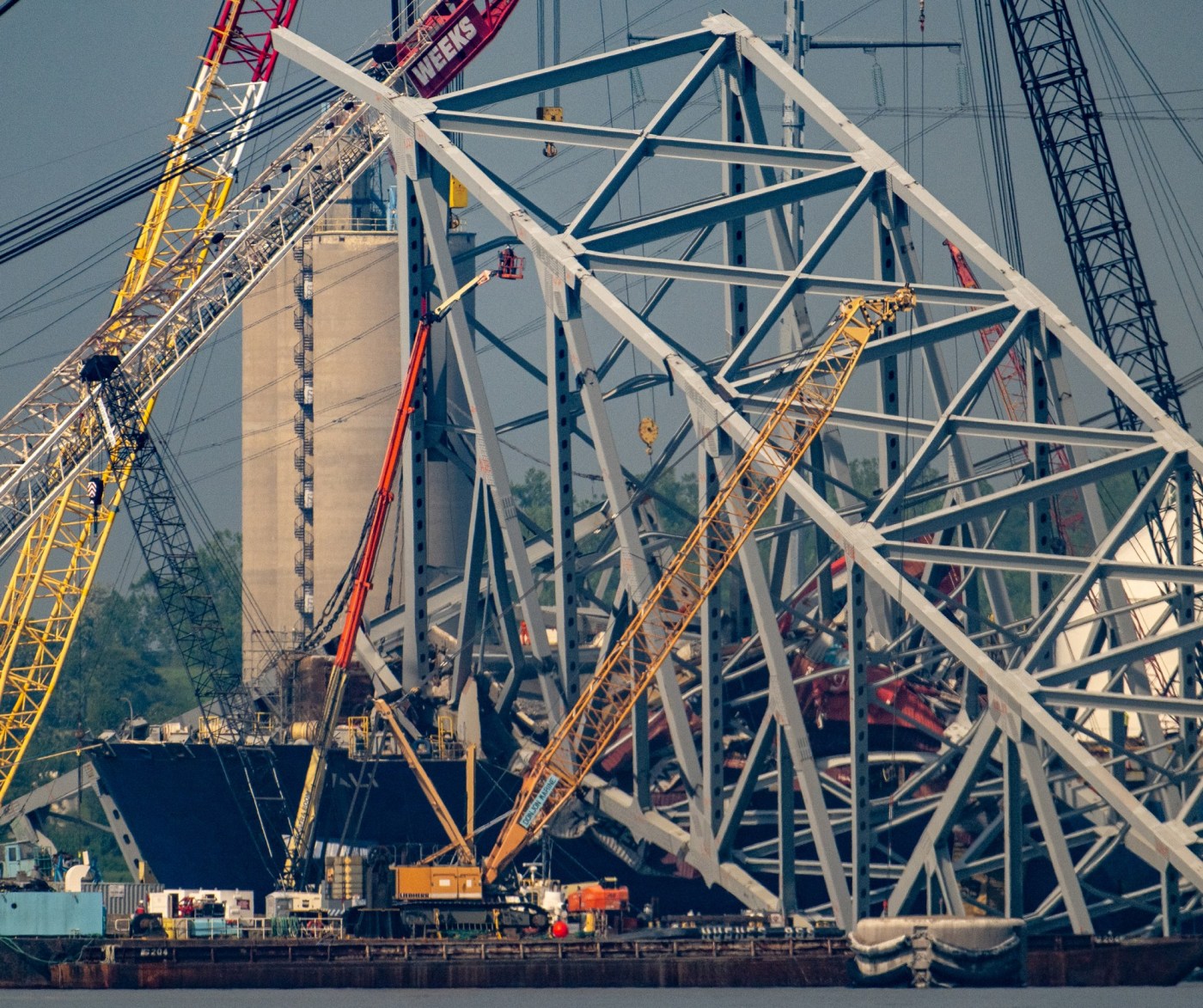The Dali has sat, entangled with the remains of the Francis Scott Key Bridge that it knocked down, for the past six weeks, becoming a Baltimore landmark as crews work to clear the channel around it of debris.
But in the most dramatic step yet to free the ship, authorities plan to use explosive devices Saturday evening to slice up a huge piece of bridge sitting atop the container ship, paving the way for it to be freed and pushed from the incident site in the coming days.
If all goes as planned, the detonation will sound like fireworks, look like puffs of smoke and plunge into the water the pieces of bridge that have weighed the ship down since the vessel appeared to lose control and crash into one of the span’s support piers March 26, killing six construction workers.
In the immediate aftermath of the explosive cuts, however, the Dali is likely to remain in the Patapsco River. Freeing a ship is a calculated, steady process and, despite the suddenness of the explosion, it is best to slowly refloat a ship, experts say.
“You want the ship to move on your terms, not its terms,” said Mike Dean, executive director of the American Salvage Association.
If a ship is made too light, too fast, it could jolt upward and swing around uncontrolled, potentially damaging its hull by bumping into a piece of debris. “The last thing you want to do is knock a hole in the ship,” Dean said.
After the explosions, which will last just a few seconds, the ship is likely to stay put for about two days, said Bobby Petty, a spokesperson for the Key Bridge Response Unified Command, as it is surveyed.
Then, he said, it will be moved to the Port of Baltimore’s Seagirt Marine Terminal. Wreckage on the ship will be removed, investigators will get back on board, the Dali’s condition will be further analyzed and the ship patched up before likely heading to a still-be-determined shipyard for further repair.
Each salvage effort presents unique challenges and the Dali, a 984-foot ship that knocked down 50,000 tons of steel and concrete, particularly so.
Dean, the former executive director of the Navy’s salvage and diving division, worked to free more than 20 ships over his career but never saw a situation in which a bridge sat on a ship.
Dan Magone, a salvor based in Alaska, has directed 79 efforts to free ships a minimum of 58 feet in length and wrote a book, “Port of Refuge,” about his varied experiences.
“I never did anything twice,” he said.
Clearing off the bow
Resolve Marine, a global vessel salvor that Magone once worked for, is leading efforts to free ship. It tapped Controlled Demolition Inc., a Baltimore County firm, as a subcontractor.
Rather than tasking a crew with physically cutting the steel that’s on the ship, which could shift and potentially cause injury, Unified Command said in a news release that it will use “precision cuts made with small charges,” which it called the “safest and swiftest method to remove the bridge piece.”
Magone said he had always assumed authorities would use explosives to make cuts at some point. Doing so, he said, allows cuts to be made simultaneously or in a precise order, rather than relying on humans torching parts of the steel at different paces. It’s hard to predict the various tensions present on the piece of bridge, so after making a cut, debris could potentially hurt a worker.
“To do anything without explosives would just be fiddling around,” Magone said.
Crews have cut into the steel and will place small charges inside those cuts, which will then be “encased with a wrap similar to a large piece of tape” and detonated, according to Unified Command. The 21-person crew still aboard the Dali will shelter in place during the event.
The explosive approach is expected to clear the 8- to 12-million-pound piece of Interstate 695 that is lying across the Dali’s bow. Crews will later retrieve the blown-apart chunks from the water, Petty said.
[cnx_script_code]PHNjcmlwdCBpZD0iMDIxZmM4MTk3YTQ0NGU3MWE5MDM5MDQxY2EyOTFlNjUiIGNsYXNzPSJjbngtdmlkZW8tZW1iZWQiPgoobmV3IEltYWdlKCkpLnNyYyA9ICdodHRwczovL2NhcGkuY29ubmF0aXguY29tL3RyL3NpP3Rva2VuPTQ2M2M3ZjQzLWIwMGItNDYzOS05MDg2LTQ3MDZhNTRjODRmNSZjaWQ9MzhkNWRhYTMtMThhYy00ZWUxLWE5MDUtMzczYzY3NjIyZjI1JzsKICBjbnguY21kLnB1c2goZnVuY3Rpb24oKSB7CiAgICBjbngoewogICAgICBwbGF5ZXJJZDogIjQ2M2M3ZjQzLWIwMGItNDYzOS05MDg2LTQ3MDZhNTRjODRmNSIKLCAgICAgIG1lZGlhSWQ6ICIwOWUzZjMxZC03NzM4LTRjYWEtYjlhZC0yMDE2NDFiMzY4OWQiCiAgICB9KS5yZW5kZXIoIjAyMWZjODE5N2E0NDRlNzFhOTAzOTA0MWNhMjkxZTY1Iik7CiAgfSk7Cjwvc2NyaXB0Pg==[/cnx_script_code]
During the explosion, which will take place sometime after 5:30 p.m. Saturday, people within 2,000 yards are asked to wear hearing protection. That zone mostly covers water, but does include a few businesses on Hawkins Point.
“This controlled demolition is not like what you would see in a movie,” states an animation from Unified Command. “From a distance, it will sound like fireworks or loud thunder and appear as puffs of smoke.”
Unified Command intends to detonate the devices during a low tide. That will likely leave the ship slightly aground, even after the bridge pieces are removed, Dean said. Authorities will later refloat the ship using a combination of a high tide and potentially the discharge of ballast water.
Paramount to salvage efforts are surveys and analysis, said Tom Gilmour, a retired Coast Guard rear admiral who is a maritime consultant.
“You don’t want to be surprised,” he said.
Surveying the aftermath
Crews will have to see where the pieces land after blowing apart the bridge section weighing down the Dali’s bow.
That will include an inspection of the ship, where it is and what the wreckage looks like underneath. A fresh survey of the riverbed might need to be conducted. Some dredging could be needed to get the ship floating, Petty said.
Related Articles
Battered South prepares for another round of storms
Baltimore authorities say they have recovered final bridge victim
As deadly floods grip Kenya, president postpones school reopening
Baltimore bridge replacement will take 4 years, almost $2B
Major Connecticut traffic route to close for days after bridge crash
Authorities will have to bear in mind a Baltimore Gas and Electric pipeline and an old Baltimore City water main, which lie beneath the riverbed near the ship. The gas pipeline has been “inerted,” or purged of its gas, but officials will still seek to avoid any damage to it as debris plummets from the ship and onto the riverbed, experts say.
The ship is being held down by six mooring lines, keeping it steady from forces like high tides, fast winds and wakes from vessels passing through temporary channels nearby.
The ebb and flow between tides this weekend near Hawkins Point are expected to be around a foot. Crews plan to wait for a high tide for a better chance at refloating the ship, Petty said, also noting that in a best-case scenario, the Dali could be refloated immediately after the inspection.
The Baltimore Sun has obtained an email that indicates the Dali is expected back in port “on or about May 14.” It was sent to attorneys for claimants who have filed against the shipping companies that own and manage the Dali.
But that timing could change. Weather, which has been uncooperative this week, is a contributing factor.
“There are a lot of variables,” Petty said.
Bringing the Dali in
After being cleared to move, the Dali will make its way to the Seagirt Terminal, Petty said.
How it gets there will depend on the circumstances — Petty said that tugboats will “more likely than not” need to push it to the dock, which is a little over 2 nautical miles from where the ship has been stranded since late March.
Removing the ship from the incident area is a key step in opening up the primary, 50-foot shipping channel, which authorities have said will be completed by the end of May. That will bring an economic lift to the Port of Baltimore, which has seen limited activity since the bridge collapse blocked the channel.
The Dali is expected to stay at Seagirt Terminal for a few weeks while the wreckage embedded in the deck is cleared. Some of the containers onboard will be unloaded, too, to make the deck accessible.
The email to claimants said the National Transportation Safety Board, which is investigating the incident along with the FBI and other agencies, plans to be on board Tuesday and Wednesday. After investigators disembark, claimants will be allowed to come onto the vessel starting May 20 for inspections they requested aboard the ship.
Temporary repairs could be made at Seagirt to the Dali, whose bow was severely gashed by the bridge.
Any temporary fixes at Seagirt don’t necessarily mean the Dali will be home-free — it may have to travel to a shipyard for permanent repairs. It’s “way too early to know,” Petty said, where the Dali might go, as engineers will have to conduct a thorough inspection once the truss is removed from the deck.












